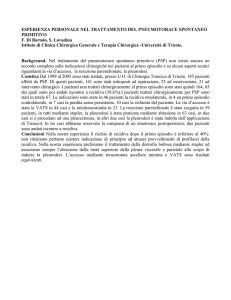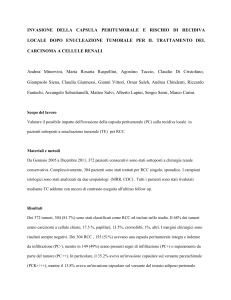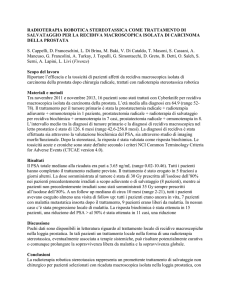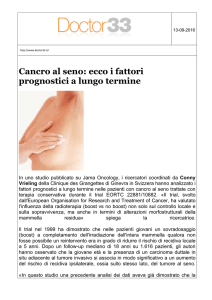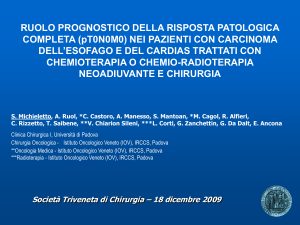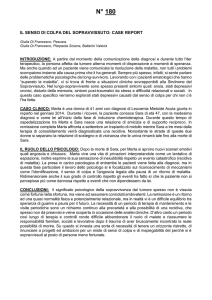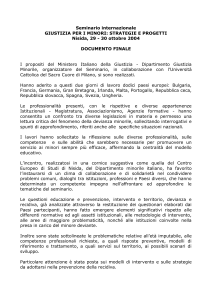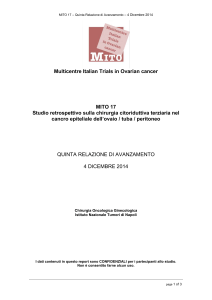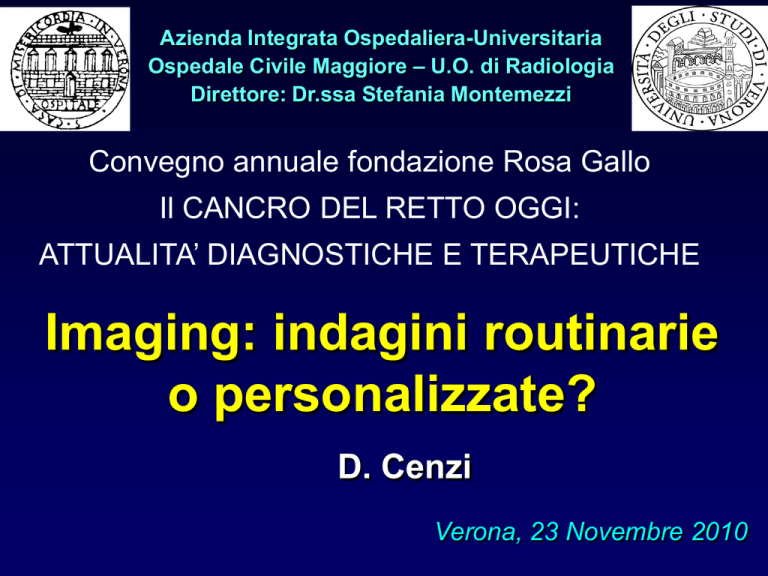
Azienda Integrata Ospedaliera-Universitaria
Ospedale Civile Maggiore – U.O. di Radiologia
Direttore: Dr.ssa Stefania Montemezzi
Convegno annuale fondazione Rosa Gallo
Il CANCRO DEL RETTO OGGI:
ATTUALITA’ DIAGNOSTICHE E TERAPEUTICHE
Imaging: indagini routinarie
o personalizzate?
D. Cenzi
Verona, 23 Novembre 2010
Quesiti all’Imaging
• Bilancio loco-regionale di malattia
• Ristadiazione post-trattamento
neoadiuvante (“downstaging”)
• Stadiazione a distanza
• Follow up
Valutazione pre-operatoria
Blomqvist L, Glimelius B, Acta Oncol 2008
Bilancio loco-regionale
• Diffusione radiale della neoplasia (T)
superiore
20%
• Rapporti con il mesoretto Retto
(CRM
e fascia
mesorettale)
Retto medio 45%
• Rapporti con il piano muscolare sfinteriale
Retto inferiore 35%
• Invasione vascolare peritumorale
• Stato dei linfonodi loco-regionali
Diffusione radiale
• Accuratezza EUS: 69-97%
Courtesy
Minicozzi A.
• Accuratezza
TC multislice: 83%
• Accuratezza RM: 67-86%
Rapporti con il mesoretto
Spazio del Retzius
Spazio intraperitoneale
Vescica
peritoneo
mesoretto
Fascia
mesorettale
retto
Il CRM
“ It is thought to be a cut-off distance of 6 mm
between a tumor and the mesorectal fascia. This
criterion was highly accurate in predicting CRM
involvement. A distance of at least 5 mm between a
tumor and the mesorectal fascia at MR imaging helped
predict an uninvolved CRM of 1 mm at histologic
analysis with 97% confidence. ”
Beet-Tan et al., Radiology 2004
Rapporti con il piano muscolare
“Phased
array MRI is accurate in measuring the
distance between the anorectal junction and the distal
part of the tumour; it is also accurate for determining the
length of the tumour. Both endorectal MRI and phased
array MRI are reliable in assessing sphincter infiltration.
EUS is the preferred method but when it is
not available the external phased array technique is
recommended over an endoanal coil MR technique
because it is easier for the patient to tolerate.”
EURECA-CC2, Radiotherapy and Oncology 2009
Infiltrazione vascolare
• Sensibilità ed specificità della RM nel riscontro di
diffusione microvascolare extraparietale (EMVI): 62 e
88%
• Il grading RM-EMVI può esser utile nel predire il
rischio di recidiva di malattia.
Smith NJ et al., British J Surgery 2008
Diffusione linfonodale
Linfonodi patologici
“
If a node was defined as suspicious because of an
irregular border or mixed signal intensity, a superior
accuracy was obtained and resulted in a sensitivity 85%
and a specificity of 97%. Prediction of nodal involvement in
rectal cancer with MR imaging is improved by using the
border contour and signal intensity characteristics of
lymph nodes instead of size criteria.”
Brown G et al., Radiology 2003
Downstaging post-CRT
Grading (TRG) secondo Dwork
•
Grado 1: completa regressione; non residuo
tumorale; fibrosi.
•
Grado
2: rare cellule
• Residuo
di neoplastiche
malattia residue o
piccoli aggregati cellulari neoplastici.
• Distinzione fibrosi post-trattamento
•
Grado 3: ampie aree di regressione con
fibrosi e necrosi frammiste a grandi aggregati
neoplastici residui.
•
Grado 4: residuo tumorale con alcune aree di
regrassione neoplastica.
•
Grade 5: tumore residuo senza elementi di
regressione.
Downstaging post-trattamento
neoadiuvante
Courtesy D. Rubello - G. Grassetto
Down-staging post-CRT
Rivalutazione del CRM
• Buona accuratezza (83-89%) nella
ridefinizione dei rapporti con CRM
T3d
Kim DJ et al., Radiographics 2010
T3c
Downstaging post-trattamento
neoadiuvante
• FDG PET-CT:
- 55% dei residui tumorali sono sottostadiati come T0
Capirci et al, Biomed Pharmacother 2004
Kristiansen et al, Dis Colon Rectum 2008
• RM:
Guerra L et al., Abdom Imaging 2009
- 75-100% delle risposte complete sono sovrastadiate
Chen et al, Dis Colon Rectum 2005
Kuo et al, Dis Colon Rectum 2005
Maretto et al, Annal Surg Oncol 2007
Kulkarni et al, Colorectal Disease 2008
Down-staging post-CRT
Risposta al trattamento
T3
pT0
T1-T2
Down-staging post-CRT
Diffusion RM
?
Pre-trattamento
pT2
Post-trattamento
DWI (b1000)
pT0
?
Courtesy Lambregts DMJ et al., ECR 2010
Follow up
• Riscontro di metastasi a distanza
• Recidiva locale di malattia
TC
Accuratezza complessiva: 87%
TC 15/09/2008
TC 13/11/2010
TC 24/09/2007
TC 13/08/2008
Riscontro metastasi a distanza
Metodiche “a la carte”
• TC
“ CT, MRI and PET/CT have proven to be accurate in
• RM e CEUS
the follow up rectal cancer. On the other hand, a debate
exists on
which imaging
procedure should be part of
• TC-PET
e RM-PET
an evidence-based
surveillance
• Whole Body
RM e program.
Diffusion” RM
Schaefer O and Langer M., Eur Radiology 2007
Riscontro metastasi a distanza
Courtesy D. Rubello - G. Grassetto
Riscontro metastasi a distanza
Recidiva locale
Pattern di recidiva
Pattern di recidiva
Operabile?
• Compartimento centrale
• Compartimento anteriore
inferiore alla riflessione
peritoneale
• Compartimento posteriore
inferiormente a S2
• Perineale
• Compartimento laterale
• Infiltrazione nervo
sciatico
• Infiltrazione sacrale di
S1-S2
• Perforazione peritoneale
Recidiva locale
Recidiva anastomotica
“
La
TC
ha
un’accuratezza
medio-bassa
nell’identificare le recidive locali (68-76%). ”
TC 24/09/2007
Fiocchi F et al., Radiologia Medica 2010
TC 13/08/2008
Courtesy D. Rubello - G. Grassetto
Recidiva locale
Recidiva comparto laterale
Recidiva locale
Recidiva perineale
Recidiva locale
Recidiva comparto postero-laterale
Follow up: che fare?
Confronto con TC precedenti
Sospetto di
recidiva locale
RM pelvi per definire la recidiva
locale
RM positiva - CEA elevato
Diagnosi di recidiva:
è resecabile?
RM positiva - CEA normale
FDG-PET TC
Follow up: che fare?
Incremento CEA
Revisione accurata di tutte le TC
precedenti
Negativa
RM pelvi per escludere
recidiva locale
FDG-PET TAC
RM epatica con mdc
epatospecifico


